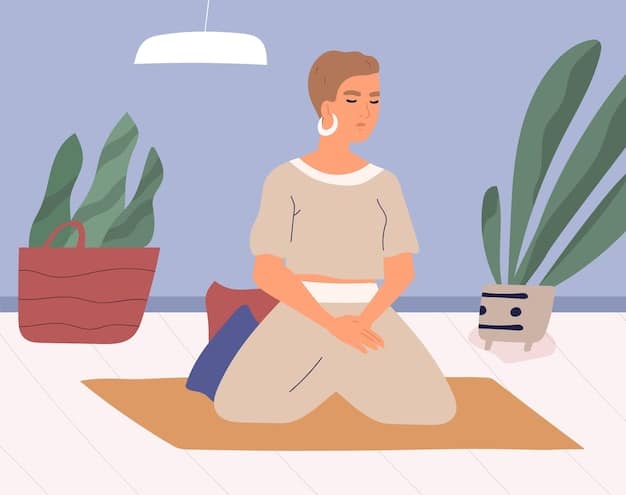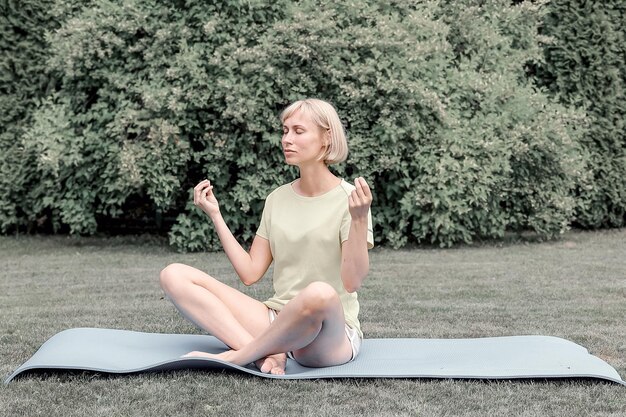Conquer Anxiety: Body Scan Meditation Techniques for Calm

Conquer Anxiety with Body Scan Meditation by tuning into your body’s sensations, releasing tension, and fostering a sense of calm through focused awareness, a proven technique that brings mindfulness to each part of your body.
Feeling overwhelmed by anxiety? Discover how to conquer anxiety with body scan meditation: a proven technique for calming your nerves, reducing stress, and finding inner peace through mindful awareness of your body.
What is Body Scan Meditation?
Body scan meditation is a simple yet powerful mindfulness technique that involves bringing your attention to different parts of your body, one by one. This practice helps you become more aware of physical sensations, thoughts, and emotions without judgment.
By systematically scanning your body, you can identify areas of tension, discomfort, or relaxation. This awareness empowers you to release tension and cultivate a deeper sense of connection with your body.
The Core Principles of Body Scan
At its heart, body scan meditation is about cultivating present moment awareness. Here are the key principles:
- Mindful Attention: Focus on one body part at a time.
- Non-Judgment: Observe sensations without criticism.
- Acceptance: Acknowledge what you feel without resistance.
- Relaxation: Allow tension to dissipate naturally.
When practiced regularly, body scan meditation can significantly reduce anxiety levels, improve sleep quality, and enhance overall well-being. It’s a valuable tool anyone can use to regain control over their mental and physical state.

In conclusion, body scan meditation is a user-friendly and impactful technique for those aiming to boost their mental and physical well-being. By prioritizing mindful attention, non-judgmental observation, and acceptance, you can effectively unlock the potential for relaxation and alleviate tension. Regularly engaging in this practice holds the promise of substantial improvements in managing anxiety and enhancing sleep quality.
How Body Scan Meditation Helps Anxiety
Anxiety often manifests as physical tension in the body. Body scan meditation addresses this directly by teaching you to identify and release this tension.
This technique can help break the cycle of anxiety by grounding you in the present moment and reducing the tendency to get caught up in anxious thoughts. Here’s how it works:
- Reduces Physical Tension: By focusing on each body part, you encourage muscles to relax.
- Grounds You in the Present: It shifts your focus from future worries to current sensations.
- Increases Self-Awareness: You become more attuned to your body’s signals of stress.
By bringing awareness to your body, you can develop a more compassionate and understanding relationship with yourself. This can lead to reduced feelings of anxiety and increased emotional resilience.
Scientific Backing for Anxiety Reduction
Research has shown that body scan meditation can be an effective tool for managing anxiety. Studies have demonstrated its ability to lower cortisol levels (the stress hormone) and improve overall mental health.
Moreover, by practicing regularly, you can train your brain to respond differently to stress, reducing the intensity of anxiety symptoms over time. It’s a proactive approach to mental wellness that puts you in control.
Step-by-Step Guide to Body Scan Meditation
Getting started with body scan meditation is easier than you might think. With a few simple steps, you can begin experiencing its benefits today.
Here’s a comprehensive guide to help you get started:
- Find a Quiet Space: Choose a place where you won’t be disturbed.
- Lie Down or Sit Comfortably: Get into a relaxed position on the floor or in a chair.
- Close Your Eyes: Gently close your eyes to minimize distractions.
- Start with Your Toes: Bring your attention to the sensations in your toes.
- Move Upward: Gradually move your focus up your body, one section at a time.
- Notice Sensations: Pay attention to any sensations you feel, without judgment.
- Breathe Deeply: Maintain a calm and steady breath throughout the practice.
Remember, the goal isn’t to eliminate sensations but to observe them. Allow yourself to feel whatever arises without trying to change it. This acceptance is a crucial part of the process.

In conclusion, following this step-by-step guide can significantly improve your practice of body scan meditation. It’s crucial to choose a peaceful and quiet environment, assume a comfortable position, and progressively focus your attention on each body part. By accepting any sensations that arise without judgment, this technique stands out as an effective way to alleviate tension and anxiety.
Tips for a Successful Body Scan Meditation
To make the most out of your body scan meditation practice, consider these helpful tips and tricks.
These strategies can enhance your experience and improve its effectiveness:
Creating a Relaxing Environment
- Minimize Distractions: Turn off your phone and find a quiet space.
- Set the Mood: Use soft lighting or calming music.
- Comfortable Clothing: Wear loose, comfortable clothes to avoid physical distractions.
Mindfulness Techniques
- Start Slowly: Begin with shorter sessions (5-10 minutes) and gradually increase the duration.
- Stay Present: If your mind wanders, gently guide your attention back to your body.
- Be Patient: It takes time to develop a mindful connection with your body.
Consistency is key to seeing results. Aim to practice body scan meditation regularly, even if it’s just for a few minutes each day. Over time, you’ll notice a significant improvement in your ability to manage anxiety and stress.
Common Challenges and How to Overcome Them
While body scan meditation is generally straightforward, some common challenges can arise. Knowing how to address these issues can keep your practice on track.
Here are some typical obstacles and practical solutions:
Mind Wandering
It’s natural for your mind to wander during meditation. When this happens, don’t get frustrated. Simply acknowledge the thought and gently redirect your attention back to your body.
Techniques to help manage mind-wandering include:
- Focus on Breathing: Use your breath as an anchor to stay present.
- Acceptance: Acknowledge thoughts without judgment.
- Mental Note: Label the thought (‘thinking’) and return to the body scan.
Physical Discomfort
Sometimes, you might experience physical discomfort during the body scan. Instead of resisting the discomfort, try to observe it with curiosity.
- Adjust Your Position: Make small adjustments to find a more comfortable stance.
- Breathe Into the Discomfort: Visualize your breath moving through the uncomfortable area.
- Acknowledge and Accept: Recognize the sensation without trying to change it.
By addressing these challenges with patience and understanding, you can deepen your body scan meditation practice and unlock its full potential for anxiety relief.
Integrating Body Scan Meditation into Daily Life
To truly benefit from body scan meditation, integrate it into your daily routine. This can be done in various ways, depending on your lifestyle and preferences.
Here are some practical ideas to incorporate body scan meditation into your everyday life:
Morning Routine
Start your day with a short body scan meditation to set a calm and centered tone. This can help you approach the day with more clarity and resilience.
During Breaks
Take short breaks throughout the day to check in with your body. A quick body scan can help release tension and reduce stress during work or other activities.
Before Bed
Practice body scan meditation before bed to relax your body and mind, promoting better sleep quality.
Body scan meditation can be practiced anytime, anywhere. The key is to make it a habit. By consistently incorporating this technique into your daily life, you’ll experience greater emotional balance and reduced anxiety over time.
| Key Point | Brief Description |
|---|---|
| 🧘 Awareness of Sensations | Focusing on bodily sensations helps you stay grounded and reduce anxiety. |
| 😌 Tension Release | Body scan meditation aids in identifying and releasing physical tension associated with anxiety. |
| ⏱️ Consistent Practice | Regular practice enhances self-awareness, calmness, and emotional balance. |
| 🧠 Management of Mind-Wandering | Techniques to redirect focus back to the body during meditation sessions. |
[Frequently Asked Questions]
▼
A typical body scan session lasts for about 20 to 30 minutes, but beginners can start with shorter 5 to 10-minute sessions and gradually increase the duration as they become more comfortable with the practice.
▼
While body scan meditation is an effective tool for reducing anxiety symptoms, it might not eliminate anxiety entirely. It can help manage and alleviate anxiety by promoting relaxation and reducing stress levels.
▼
No, you can practice body scan meditation while sitting in a comfortable position or even standing. The key is to ensure you are relaxed and will not be disturbed during the session.
▼
For best results, aim to practice body scan meditation daily or at least several times a week. Regular practice will help you become more attuned to your body and better manage anxiety over time.
▼
It’s perfectly normal not to feel anything during the body scan, especially when starting. Simply observe your experience without judgment, and continue to bring your attention to each body part as instructed. Sensations may arise gradually with practice.
Conclusion
By incorporating it consistently, you can reduce anxiety, increase self-awareness, and improve your overall well-being, making it an essential practice for a calm and balanced life.





